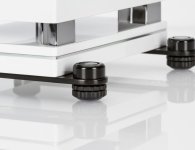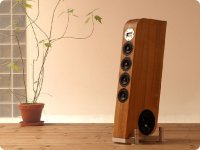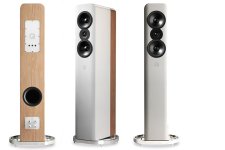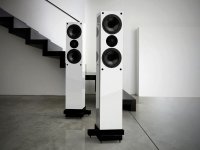- Thread Author
- #1
You are using an out of date browser. It may not display this or other websites correctly.
You should upgrade or use an alternative browser.
You should upgrade or use an alternative browser.
Are reviewers who measure speakers smarter than the designers?
- Thread starter Mike
- Start date
Kuoppis
New member
- Joined
- Jan 19, 2015
- Messages
- 5,203
I think the Audiophiliac has a point there.
If you could make the best products by just optimizing the measurements, it would rather easy. But as in certain areas, such as DAC circuits, the ever so slightest difference can have an audible impact, it unfortunately is not that easy.
Good example is John Atkinson’s measurements of the Nyquist DAC. The DAC sounds awesome, but there is some distortion in the inaudible band he makes a huge fuss about. Background is that it results from the analog filtering in the world-class Lundahl transformers. Those could be tuned more tightly, but then the DAC would not sound so nice. And as it is inaudible, the fuss is a little incomprehensible in the first place.
Measurements for measurement sake are indeed not meaningful.
Sent from my iPad using Tapatalk
mep
Well-known member
- Joined
- Dec 4, 2013
- Messages
- 5,109
I think the Audiophiliac has a point there.
If you could make the best products by just optimizing the measurements, it would rather easy. But as in certain areas, such as DAC circuits, the ever so slightest difference can have an audible impact, it unfortunately is not that easy.
Good example is John Atkinson’s measurements of the Nyquist DAC. The DAC sounds awesome, but there is some distortion in the inaudible band he makes a huge fuss about. Background is that it results from the analog filtering in the world-class Lundahl transformers. Those could be tuned more tightly, but then the DAC would not sound so nice. And as it is inaudible, the fuss is a little incomprehensible in the first place.
Measurements for measurement sake are indeed not meaningful.
Sent from my iPad using Tapatalk
You should probably go back and reread what JA said about the measurements he took. He wasn't just talking about distortion in the "inaudible band" as you described. He also talks about increased distortion at low frequencies. Anybody can read exactly what JA said here:
https://www.stereophile.com/content/brinkmann-audio-nyquist-da-processor-measurements
CPP
Active member
You should probably go back and reread what JA said about the measurements he took. He wasn't just talking about distortion in the "inaudible band" as you described. He also talks about increased distortion at low frequencies. Anybody can read exactly what JA said here:
https://www.stereophile.com/content/brinkmann-audio-nyquist-da-processor-measurements
Mr Measurement notes "" Overall, I was disappointed by the Brinkmann Nyquist's measured performance. The higher-than-usual levels of random noise, the increase in distortion at low frequencies, and the supply-related sidebands all bothered me. You shouldn't have to make excuses for a DAC costing $18,000.—John Atkinson "
So why does the DAC sound so good to some, maybe it was designed using ears first vs a scope second. Makes you wonder, I still let my ears decide.
Kuoppis
New member
- Joined
- Jan 19, 2015
- Messages
- 5,203
Mr Measurement notes "" Overall, I was disappointed by the Brinkmann Nyquist's measured performance. The higher-than-usual levels of random noise, the increase in distortion at low frequencies, and the supply-related sidebands all bothered me. You shouldn't have to make excuses for a DAC costing $18,000.—John Atkinson "
So why does the DAC sound so good to some, maybe it was designed using ears first vs a scope second. Makes you wonder, I still let my ears decide.
I must say I agree. For me personally sound comes first, measurements second.
It is maybe not just me thinking Atkinson was amiss here. Harley, Sircom, Böde etc. did not measure or notice anything they did not like in their reviews, and they all measured it. And they went further, lauding the Nyquist with their highest awards.
I think this sort of thing is what the audiophiliac is pointing out. Reviewers sometimes come up with obscure measurements and make a big noise about them for no reason.
Sent from my iPad using Tapatalk
- Thread Author
- #6
(More on measurements)
http://www.psaudio.com/pauls-posts/the-beauty-of-measurements/
Sent from my iPhone using Tapatalk
http://www.psaudio.com/pauls-posts/the-beauty-of-measurements/
Sent from my iPhone using Tapatalk
AJ Soundfield
Well-known member
1) Because it costs $18k.So why does the DAC sound so good to some
2) It's made by BlingAudio, Inc.
3) Reviewer-prophet said so therefore it's gospel. They say, I believe.
4) I like distortion.
5) My demonstrable hearing skills/ability is poor, I can't hear the distortions, therefore they are "inaudible" to all.
6) All of the above
Careful now Chris, that is by definition a blind test. Ears decide = blind.I still let my ears decide.
Awful slippery slope.
Now, eyes, price, looks, street cred, Stereophile, ears, bank account, etc, etc decide, sure!
Measurements OTOH, not so much.
a.wayne
Well-known member
Loaded question,
Both have totally different tasks, the designer is giving his interpretation of the science (house sound) and the reviewers job is to critique that interpretation...
Regards
AJ Soundfield
Well-known member
Speaker measurement shows a sharp glitch in the impedance and a corresponding high Q bump/dip but small +/-2db magnitude at 1500hz, then a relatively broad Q 12db peak at 17kHz.
65+ (?) year old Steve Guttenberg, "well, it sounds fine to me, hmmm".
Conclusion, measurements are useless.
a.wayne
Well-known member
Maybe nonmeasuring reviews /Reviewers are useless.... 
Tom Norton was a past speaker designer himself , solid reviewer ..
Regards
Tom Norton was a past speaker designer himself , solid reviewer ..
Regards
AJ Soundfield
Well-known member
JA isn't too shabby but seriously, 95% of "reviewers" haven't (can't) performed an electro-acoustic measurement in their adult life.
Pretty sure SG falls into this category, so why throw stones...
Pretty sure SG falls into this category, so why throw stones...
Well, i don´t know… :doubtful:
To me, the subject is not only about measurements, it´s about the flaws that the reviewers or the final consumer (audiophiles) can notice in some gear, be it using their ears or a microphone and a computer…
I usually think and say that I really don´t know nothing about electronics, but I became to understand a little of audio…
In my opinion, some engineers don´t get the all picture in audio. Tell me who are the designers that don´t believe in the influence of cables, tell me who are those who don´t believe in the importance of vibrations, tell me who are those who don´t believe that a simple fuse can change the sound and I tell you I never buy a product from them. irate:They simply are not “there”, yet!
irate:They simply are not “there”, yet!
You know these engineers exist. They certainly know a lot of electronics, but they took just one direction, so they can´t have an integrated vision of all the problems in audio reproduction. Sometimes I read some of them invocating the God of Science to stay in their throne.
A simple example: since I notice that cables “talk” with each others when they are close, when I see photos of some gear with all the internal cables crossing all the sections of the equipment and all of them fastened with a clamp I say to myself: this can´t sound neutral. And in all the cases I have the chance to listen them, sure I confirm my theory.
So, yes I think is possible the reviewers find some faults that the designers never think of.
The good news: there are some designers who learned from their experience and are now paying attention to the detail that can make the difference between a good and a top sound.
Speaking only about speakers, did you notice the new solutions in decoupling the speakers from the floor? There´s no doubt that a bad solution can really compromise the performance and the product.
Some examples:




To me, the subject is not only about measurements, it´s about the flaws that the reviewers or the final consumer (audiophiles) can notice in some gear, be it using their ears or a microphone and a computer…
I usually think and say that I really don´t know nothing about electronics, but I became to understand a little of audio…
In my opinion, some engineers don´t get the all picture in audio. Tell me who are the designers that don´t believe in the influence of cables, tell me who are those who don´t believe in the importance of vibrations, tell me who are those who don´t believe that a simple fuse can change the sound and I tell you I never buy a product from them.
You know these engineers exist. They certainly know a lot of electronics, but they took just one direction, so they can´t have an integrated vision of all the problems in audio reproduction. Sometimes I read some of them invocating the God of Science to stay in their throne.
A simple example: since I notice that cables “talk” with each others when they are close, when I see photos of some gear with all the internal cables crossing all the sections of the equipment and all of them fastened with a clamp I say to myself: this can´t sound neutral. And in all the cases I have the chance to listen them, sure I confirm my theory.
So, yes I think is possible the reviewers find some faults that the designers never think of.
The good news: there are some designers who learned from their experience and are now paying attention to the detail that can make the difference between a good and a top sound.
Speaking only about speakers, did you notice the new solutions in decoupling the speakers from the floor? There´s no doubt that a bad solution can really compromise the performance and the product.
Some examples:
Attachments
a.wayne
Well-known member
JA isn't too shabby but seriously, 95% of "reviewers" haven't (can't) performed an electro-acoustic measurement in their adult life.
Pretty sure SG falls into this category, so why throw stones...
Agree,
JA is solid , i mentioned Tom as i have always thought of JA's position as head honcho in this audio Minefield as being academic ....
a.wayne
Well-known member
Love the look of the second pic
...
In my opinion, some engineers don´t get the all picture in audio. Tell me who are the designers that don´t believe in the influence of cables, tell me who are those who don´t believe in the importance of vibrations, tell me who are those who don´t believe that a simple fuse can change the sound and I tell you I never buy a product from them.irate:They simply are not “there”, yet!
Can you name one product designer (engineer) who believes "audiophile" fuses make a difference? Because there are any number who have stated they make no difference (of my equipment, Nelson Pass and Dan Wright).
Kuoppis
New member
- Joined
- Jan 19, 2015
- Messages
- 5,203
I try to purchase components that sound great and measure well. In the few instances where I purchased a component that I thought sounded great but didn't measure well, it came back to bite me at a later date.
Ken
Would tend to agree with that, this is of course given the measurements are meaningful.
If there are e.g. distortions above 40 kHz as in DSD I am not sure whether I care, as I do not have ultrasonic hearing.
Sent from my iPad using Tapatalk
AJ Soundfield
Well-known member
I do. :hey:Can you name one product designer (engineer) who believes "audiophile" fuses make a difference?
Many of those magic fuses can't meet basic certification. That means, when the time comes for them to perform that actual electrical function of a "fuse", they won't! That will certainly make a difference in the sound coming from the system.
AJ Soundfield
Well-known member
Any single measurement is of course only a snapshot. The photo album is best.
mep
Well-known member
- Joined
- Dec 4, 2013
- Messages
- 5,109
Would tend to agree with that, this is of course given the measurements are meaningful.
If there are e.g. distortions above 40 Hz as in DSD I am not sure whether I care, as I do not have ultrasonic hearing.
Sent from my iPad using Tapatalk
You keep changing the story and I think you meant to say distortions above 40 kHz not 40 Hz. The fact is that JA said the Nyquist has low frequency distortion and high frequency distortion. It’s also noisy. I provided the link to the measurements so people can read what JA said and not your distorted version.




